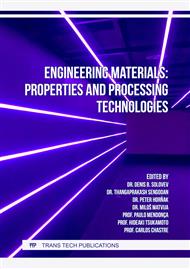[1]
N.G. Arutyunyan, A.A. Zevin, Calculation of building structures taking into account creep, Stroyizdat, Moscow, 1988.
Google Scholar
[2]
M.V. Novikov, G.S. Slavcheva, E.M. Chernyshov, Models of mechanics of structural porous concrete in conditions of long-term load action, in: Mater. VIII Acad. readings of RAASN - Internat. Sci. and Technic. conf., Mechanics of destruction of building materials and structures, KGASU, Kazan, 2014, pp.225-232.
Google Scholar
[3]
S.B. Krylov, P.D. Arleninov, Modern research in the field of creep theory of concrete, Bulletin NIC Constr. 1(16) (2018) 67-75.
Google Scholar
[4]
A.R. Rzhanitsyn, Creep Theory, Stroyizdat, Moscow, 1968.
Google Scholar
[5]
Yu.N. Rabotnov, Creep of Structural Elements, Science, Moscow, 1966.
Google Scholar
[6]
N.G. Arutyunyan, V.B. Kolmanovsky, Theory of Creep of Inhomogeneous Bodies, Science, Moscow, 1983.
Google Scholar
[7]
S.V. Aleksandrovsky, Calculation of Concrete and Reinforced Concrete Structures for Changes in Temperature and Humidity, Taking into Account Creep, Stroyizdat, Moscow, 1973.
Google Scholar
[8]
I.E. Prokopovich, V.A. Zedgenidze, Applied Theory of Creep, Stroyizdat, Moscow,1980.
Google Scholar
[9]
D.K.S. Bataev, M.A. Gaziev, Kh.N. Mazhiev, Selection of creep theory for evaluation of long-term deformation of fine autoclave cellular concrete taking into account carbonation factor, Bulletin of Dagestan State Technical University. Tech. Sci. 3(38) (2015) 94-103.
DOI: 10.21822/2073-6185-2015-38-3-94-103
Google Scholar
[10]
K.Z. Galustov, Nonlinear Theory of Concrete Creep and Calculation of Reinforced Concrete Structures, FM, Moscow, 2006.
Google Scholar
[11]
P.I. Vasiliev, The effect of aging concrete on the appearance of creep curves, Izvestia VNIIG. 57 (1957) 129-134.
Google Scholar
[12]
E.M. Chernyshov, G.S. Slavcheva, M.V. Novikov, Strength and deformability of porous concrete under short-term and long-term action of loads, in: Col. of Sci. Artic. on the Mater. of the 7th Internat. Sci. Conf., Mechanics of concrete, reinforced concrete and other building materials destruction, RAASN, Voronezh, 2013, pp.167-173.
Google Scholar
[13]
G.S. Slavcheva, E.M. Chernyshov, M.V. Novikov, New generation heat-efficient foam concrete for low-rise construction, Constr. Mater. 7 (2017) 20-24.
Google Scholar
[14]
M.V. Novikov, Design indicators of resistance of porous concrete to short-term and long-term power impacts, J. Sci. Eng. Syst. and Struct. 3-4(28-29) (2017) 57-63.
Google Scholar
[15]
M.V. Novikov, E.M. Chernyshov, G.S. Slavchev, Prochnost of normal sections of the bent elements from porizovanny concrete of natural curing, RAASN Acad. Bulletin UralNIIproekt. 1(44) (2020) 83-88.
Google Scholar
[16]
M.V. Novikov, E.M. Chernyshov, G.S. Slavcheva, Mechanical properties of cement porous concrete at uniaxial compression with due regard for regularities of its creep, Constr. Mater. 11 (2016) 26-31.
Google Scholar
[17]
M.V. Novikov, E.E. Prokshits, A.N. Goykalov, Creep and Long-Time Strength of Compression Elements from Foam Concrete, Solid State Phenomena. 284 (2018) 936-943.
DOI: 10.4028/www.scientific.net/ssp.284.936
Google Scholar
[18]
S.Z. Wulfson, To nonlinear creep theory/C.Z. Wulfson , in: a collection of scientific works, Creep of building materials and structures, Stroyizdat, Moscow, 1964, pp.84-95.
Google Scholar
[19]
E.N. Lvovsky, Statistical Methods of Constructing Empirical Formulas, Higher School, Moscow, 1988.
Google Scholar
[20]
V.M. Bondarenko, N.I. Karpenko, Stress level as a factor of structural changes and rheological strength resistance of concrete, Acad. Architect. and Constr. 4 (2007) 56-60.
Google Scholar


